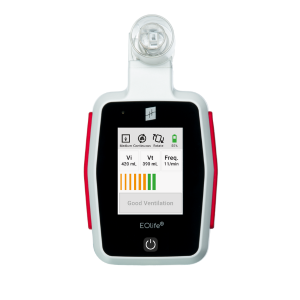CPR is a life-saving intervention for people suffering from cardiorespiratory arrest. In this article, we explore a hidden yet critical danger in manual ventilation during CPR: hypoventilation. Initially performed by lay rescuers, and then taken over by professional healthcare providers (firefighters, ambulance services, or emergency medical services), CPR relies on two main actions:
- chest compressions to maintain a semblance of blood circulation
- ventilation to ensure oxygenation and carbon dioxide removal.
During the first minutes of CPR—often the most critical for patient survival—ventilation is often performed manually by Basic Life Support (BLS) providers using a bag-valve mask (BVM) system. Although this technique may appear simple, it is in fact highly complex and, if not performed correctly, can result in inadequate ventilation and significantly compromise patient outcomes.
What is hypoventilation ?
Common definition of hypoventilation
Put simply, hypoventilation occurs when the resuscitated patient does not receive enough air to meet the body’s needs. It happens either when each breath delivers too little air, or when breaths are too infrequent. This leads to insufficient oxygen entering the body and an accumulation of carbon dioxide, which cannot be properly eliminated through gas exchange.
Consequences of hypoventilation
As a result, the brain and other vital organs may not receive the oxygen they desperately need—jeopardizing both survival and recovery. The most common consequences of hypoventilation include:
- Hypoxemia and hypoxia
- Hypercapnia
- Acidosis
- Reduced survival rates
This is not a rare issue. In fact, an American study showed that approximately 60% of patients are hypoventilated during CPR. The study revealed that high-quality manual ventilation can triple the chances of survival and quadruple the likelihood of favorable neurological recovery. With survival rates having plateaued in recent years following the widespread adoption of defibrillators, ventilation optimization now stands as the next frontier for improving patient outcomes.
EOlife, the only Ventilation Feedback Device (VFD) to display the volume of gas reaching the patient’s lungs (Tidal Volume).
CE-marked and FDA-cleared medical device enabling real-time measurement of insufflated volume, tidal volume, and ventilation frequency. It provides visual feedback to deliver ventilation following ERC or AHA recommendations.
Why hypoventilation happens during CPR ?
As mentioned above, during the early phase of CPR, ventilation is mostly delivered manually by BLS providers using a BVM system. While BVM ventilation may seem straightforward, it is deceptively complex.
The challenge of leakage management
Ensuring a proper seal between the mask and the patient’s face, while delivering the correct volume of air with each breath, requires both skill and experience—something not easily acquired by all rescuers.
Even more concerning, in the absence of any monitoring device, mask leaks are nearly impossible to detect. This leads to major inefficiencies in ventilation.
A recent study conducted by the Paris Fire Brigade revealed the gravity of this issue. Leaks were observed with a median ratio of 41%, and the average tidal volume delivered was only 280 mL, far below the 500 mL recommended for adult patients.
The primary cause of this insufficient ventilation is mask leakage, but it can also result from gastric inflation when the airways are not properly cleared.
How to avoid hypoventilation during CPR ?
Hypoventilation during CPR is therefore a life-threatening complication that must be addressed proactively. Two key solutions stand out:
Measure to improve
What is not measured cannot be improved. Devices that accurately monitor tidal volume, detect leaks, and alert rescuers in real time are essential.
The EOlife device is currently the only feedback tool capable of doing this during manual ventilation. Integrating EOlife into CPR practice can significantly improve ventilation quality and patient outcomes.
Train for better technique
Since mask leakage is a leading cause of poor ventilation, hands-on training is essential. Healthcare providers must be taught how to position the mask correctly and maintain a good seal.
Using training feedback devices like EOlife X during simulation ensures real-time evaluation of ventilation quality and helps identify and correct errors before real emergencies occur.
Hypoventilation is a silent but deadly threat in CPR, often going unnoticed while seriously compromising survival chances. The quality of ventilation matters—and it must be measured to be improved.
Ventilation feedback devices, like EOlife, play a critical role in tackling this issue. By providing real-time feedback on tidal volume and mask leakage, EOlife helps rescuers optimize every breath.
Stop hidden hypoventilation during CPR, monitor every breath with EOlife
Find out more
References
(1) Idris, A. H., Aramendi Ecenarro, E., Leroux, B., Jaureguibeitia, X., Yang, B. Y., Shaver, S., Chang, M. P., Rea, T., Kudenchuk, P., Christenson, J., Vaillancourt, C., Callaway, C., Salcido, D., Carson, J., Blackwood, J., & Wang, H. E. (2023). Bag-Valve-Mask Ventilation and Survival From Out-of-Hospital Cardiac Arrest: A Multicenter Study. Circulation, 148(23), 1847–1856.
(2) Evaluation of ventilation quality of BLS Firefighter teams during OHCA : The VECARS – 1 study. F. Lemoine, D. Jost, B Tassart, A. Petermann, S. Lemoine, M. Salome, B. Frattini, S. Travers.



